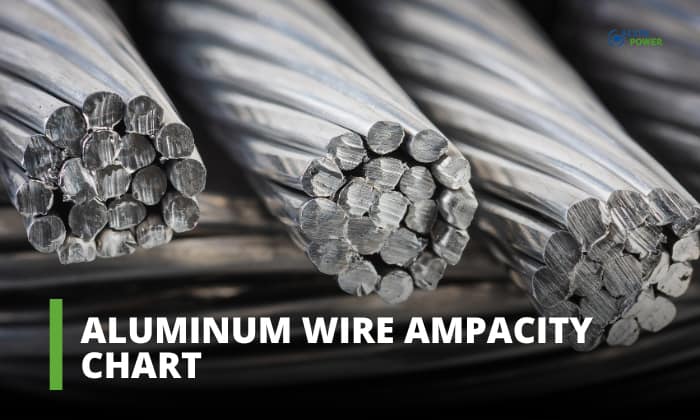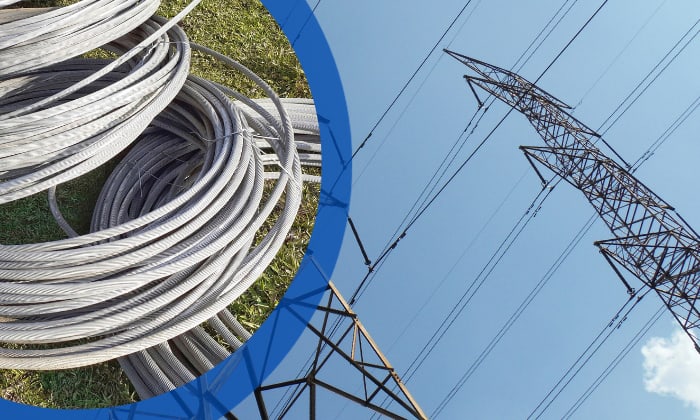Aluminum wires are a great alternative to copper wires. Their cheap cost and light weight make them popular choices for long distance electrical lines and other applications.
An aluminum wire ampacity chart can easily help you decide the right electrical wire size based on temperature. It is easy to use with the right practice, and once you get the hang of it, you can safely decide on the right cable for your needs.
Table of Contents
Ampacity of Aluminum Wires
Here is a wire gauge amp chart based on the National Electric Code, or NEC:
| Ampacity table for insulated aluminum or copper-clad aluminum conductors | ||||
| Wire size | 60⁰C | 75⁰C | 90⁰C | 150⁰C |
| Types TW and UF | Includes RHW,
THW, THWN, USE and ZW wires, among others |
Includes SA, THHN, THHW, XHH, XHHN, XHHW, XHWN and USE-2, among others | Type Z | |
| Ambient temperature 30⁰C | Ambient temperature 30⁰C | Ambient temperature 30⁰C | Ambient temperature 40⁰C | |
| 12 gauge | 15 amp | 20 amp | 25 amp | 30 amp |
| 10 gauge | 25 amp | 30 amp | 35 amp | 44 amp |
| 8 gauge | 35 amp | 40 amp | 45 amp | 57 amp |
| 6 gauge | 40 amp | 50 amp | 55 amp | 75 amp |
| 4 gauge | 55 amp | 65 amp | 75 amp | 94 amp |
| 3 gauge | 65 amp | 75 amp | 85 amp | 109 amp |
| 2 gauge | 75 amp | 90 amp | 100 amp | 124 amp |
| 1 gauge | 85 amp | 100 amp | 115 amp | 145 amp |
| 1/0 gauge | 100 amp | 120 amp | 135 amp | 169 amp |
| 2/0 gauge | 115 amp | 135 amp | 150 amp | 198 amp |
| 3/0 gauge | 130 amp | 155 amp | 175 amp | 227 amp |
| 4/0 gauge | 150 amp | 180 amp | 205 amp | 260 amp |
| 250 kcmil | 170 amp | 205 amp | 230 amp | – |
| 300 kcmil | 195 amp | 230 amp | 260 amp | – |
| 350 kcmil | 210 amp | 250 amp | 280 amp | – |
| 400 kcmil | 225 amp | 270 amp | 305 amp | – |
| 500 kcmil | 260 amp | 310 amp | 350 amp | – |
| 600 kcmil | 285 amp | 340 amp | 385 amp | – |
| 700 kcmil | 315 amp | 375 amp | 425 amp | – |
| 750 kcmil | 320 amp | 385 amp | 435 amp | – |
| 800 kcmil | 330 amp | 395 amp | 445 amp | – |
| 900 kcmil | 355 amp | 425 amp | 480 amp | – |
| 1000 kcmil | 375 amp | 445 amp | 500 amp | – |
| 1250 kcmil | 405 amp | 485 amp | 545 amp | – |
| 1500 kcmil | 435 amp | 520 amp | 585 amp | – |
| 1750 kcmil | 455 amp | 545 amp | 615 amp | – |
| 2000 kcmil | 470 amp | 560 amp | 630 amp | – |
The table lists the ampacity of wire based on the wire size and temperature.
Generally, the ampacity is limited by the wire’s insulation. The rated ampacities in the table are the maximum current the aluminum wire can safely carry without damaging its insulation.
We can directly use the table values if we meet the following criteria:
- The wires are in a cable or raceway with up to three single conductors. The values for 60⁰C, 75⁰ and 90⁰C are also true for direct-burial cables with up to three single conductors.
- The ambient temperature is met. The values for 60⁰C, 75⁰ and 90⁰C are true at an ambient temperature of 30⁰C, while the values at 150⁰C are true at an ambient temperature of 40⁰C.
If the conditions are not met, then this wire size chart cannot be directly used. The values in the table should be corrected or derated for the number of wires and ambient temperature. Most common applications, though, are rated at 90⁰C.
Let’s say you want to know how much current a 10-gauge aluminum THHN wire can carry. If the previous conditions are met, then you can check the table for a quick answer:
- Check the maximum temperature the insulation can handle. THHN wires can handle up to 90⁰C.
- Then check the wire gauge and look at the amp rating of wire at its maximum temperature. A 10-gauge aluminum THHN wire at 90⁰C can handle up to 35 amps.
Correction or Derating Aluminum Wire Ampacities
If the conditions for using the table are not met, then correction or “derating” should be done to safely use an aluminum wire. The ratings must be adjusted to prevent the wires from accumulating too much heat that can damage the insulation.
1. More Than Three Current-carrying Wires in a Cable or Raceway
If you will use more than three current-carrying conductors in a cable or raceway, then the values in the table should be reduced to the following percentages based on the number of wires:
| Number of current-carrying conductors in the cable or raceway | Percent of table values (applied AFTER correcting for ambient temperatures) |
| 4-6 | 80% |
| 7-9 | 70% |
| 10-20 | 50% |
| 21-30 | 45% |
| 31-40 | 40% |
| 41 or more | 35% |
For example, if we will use four 10-gauge aluminum THHN wires in a raceway, then its maximum current should be derated to 80%. Thus, 10 AWG ampacity should be 28 amps (80% of 35 amps).
2. Different Ambient Temperature
If the standard ambient temperature is not met, then the values in the table should be multiplied to the right correction factor:
| Ambient temperature | Table values based on ambient temperature of 30⁰C | Table values based on ambient temperature of 40⁰C | ||
| 60⁰C | 75⁰C | 90⁰C | 150⁰C | |
| 10 or less | 1.29 | 1.20 | 1.15 | 1.13 |
| 11-15 | 1.22 | 1.15 | 1.12 | 1.11 |
| 16-20 | 1.15 | 1.11 | 1.08 | 1.09 |
| 21-25 | 1.08 | 1.05 | 1.04 | 1.07 |
| 26-30 | 1.00 | 1.00 | 1.00 | 1.04 |
| 31-35 | 0.91 | 0.94 | 0.96 | 1.02 |
| 36-40 | 0.82 | 0.88 | 0.91 | 1.00 |
| 41-45 | 0.71 | 0.82 | 0.87 | 0.98 |
| 46-50 | 0.58 | 0.75 | 0.82 | 0.95 |
| 51-55 | 0.41 | 0.67 | 0.76 | 0.93 |
| 56-60 | – | 0.58 | 0.71 | 0.90 |
| 61-65 | – | 0.47 | 0.65 | 0.88 |
| 66-70 | – | 0.33 | 0.58 | 0.85 |
| 71-75 | – | – | 0.50 | 0.83 |
| 76-80 | – | – | 0.41 | 0.80 |
| 81-85 | – | – | 0.29 | 0.74 |
| 85-90 | – | – | – | |
| 91-100 | – | – | – | 0.67 |
| 101-110 | – | – | – | 0.60 |
| 111-120 | – | – | – | 0.52 |
| 121-130 | – | – | – | 0.43 |
| 131-140 | – | – | – | 0.30 |
For example, if we use 10-gauge aluminum THHN wires at an ambient temperature of 50⁰C, then their maximum current should be corrected by 0.82. Thus, the maximum current should be 28.7 amps (35 amps times 0.82).
Conclusion
An aluminum wire ampacity chart can help you decide which wire you can use based on temperature.
As long as you know the ambient temperature and the number of wires you will use in a cable or raceway, you can directly use the table values to buy your tools as needed. This guarantees the safe use of aluminum wires for electrical purposes.

I am Andrew Wright. With 8 years of experience designing, installing, and maintaining electrical power systems. I love my job, and I have always wanted to offer others the necessary help so they can take care of their houses.


